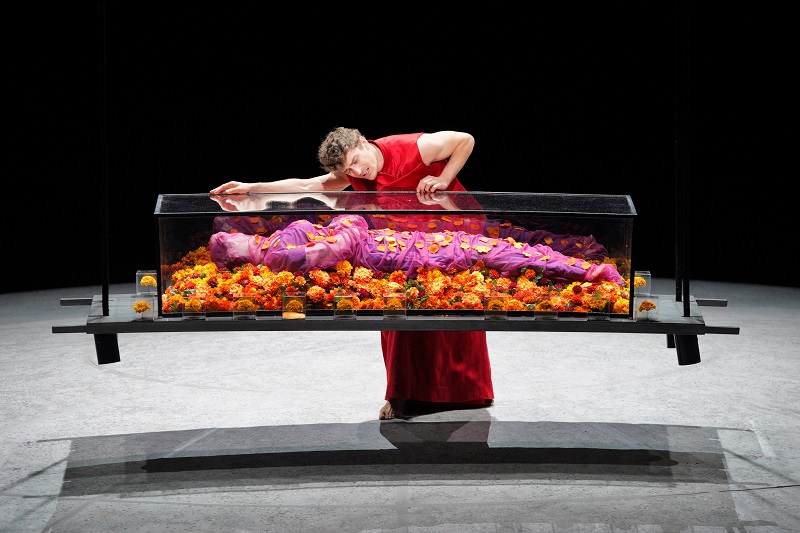
Orpheus Returns
Call the opera “Orphée,” “Orfeo,” or, like the SF Opera, “Orpheus and Eurydice”—whatever the name, the production here offers breakthroughs in many directions—a dazzling feast of primary colors and lighting, acrobatic dancers, a goddess descending from heaven on a swing, and the most nimble of males ever in the title role. This reprise of Gluck’s early classical-period opus in this memorable new production is a feast for ears and eyes, despite the severe dramatic limitation of having merely three solo singers.
This breakthrough suggests a stunning staging ability at the venerable, century-old S.F. Opera which shows future producers what can be done in this venerable hall with its stage machinery greatly updated since its floppy-canvas beginnings.
Whatever limitations there were in the other voices, nothing could ever top the most stunning high voice of countertenor Jakub Jozef Orlinski. He could project the score handsomely (from the Vienna premiere of 1762) without transpositions in a seamless clarion voice, as well as shimmy, dance, even wheel and tumble on stage like break dancers. Perhaps we can shelve for good having tenors and mezzos step in, subbing for the thoroughly male title role. Playing the huge dominant part, Orlinski put in the shade the other Orfeos previously in memory or circulation, whether in Gluck, Monteverdi or other operatic versions.
He sang the opera’s best-known aria, “What will I do without Eurydice?” while the dancers played out the famous “Dance of the Blessed Spirits.” (The noted “Dance of the Furies” was omitted, as it first appeared 12 years after the Vienna premiere.)
Composer Christoph Willibald Gluck altered the ancient Greek legend of the famous doomed lovers by appending a happy ending, with the goddess Amore pardoning Orpheus for his disobedience and bringing the twice-dead Eurydice back to life to join her disconsolate devoted husband.
In the opening sequence, I thought it was all Election Day reenactment given the vigorously athletic dancers’ red and blue outfits. But no, it was just the wild, eye-popping color scheme under director Matthew Ozawa and choreographer Rena Butler, helped by lighting wizard Alexander V. Nichols. All so bright, we should probably have worn sunglasses. The six lead dancers, who could make a pretty good gymnastics team, were so versatile, they were given separate credits in the printed program.
In Gluck, the chorus under the new Director John Keene filled the traditional augmented role with heavy responsibilities and a welcome, full sound, moving about the rotating stage as though brought up on it. Peter Whelan’s mostly-strings orchestra was the ready collaborator.
In less prominent roles were soprano Meigui Zhang (Eurydice) and Nicole Heaston (the golden goddess Amore, on a swing lowered from heaven). Zhang paired amiably in the duet with Orpheus.
Above all, the opera’s message dwells on weakness of the male character, feminine insecurity, and isolation, the latter with the first half-hour showing the lonely Orpheus on stage, meandering about the bier of the expired bride Eurydice. Even though coming from myth, the emotions here ring true millennia later.
And, if your path to Hades or anywhere is ever blocked by a chorus of Furies, rest assured: As Orpheus demonstrated, they yield and make way for songs beautifully sung!! So just try to avoid going off-key.
The entire opera is telescoped into just 90 minutes, with all the intermissions eliminated.
‘ORPHEUS AND EURYDICE’ opera by Gluck, here in Italian, with supertitles. Opera House, San Francisco, heard Nov. 18, repeating Nov. 20, 26 and Dec. 1. For info: (415) 864-3330, or go online: www.sfopera.com.